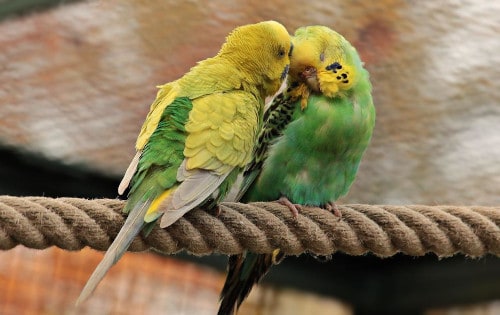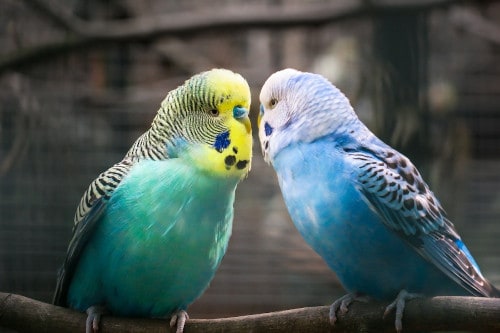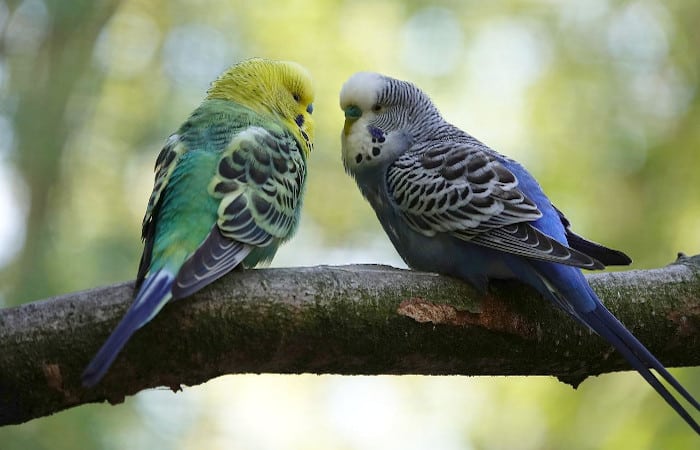When it comes to keeping parakeets, many people have the same question: should parakeets be kept in pairs or not?
The answer is…it depends.
Some people believe that parakeets should always be kept in pairs because they are social animals and need the company of others.
Others believe that it is okay to keep a single parakeet, as long as you provide enough stimulation and attention.
So, what’s the verdict? Should parakeets be kept in pairs or not?
Is it better for parakeets to live in pairs?
Parakeets are social birds, and they typically enjoy the company of their flock mates.
In the wild, parakeets live in flocks of up to 100 birds, so it’s no surprise that they prefer to have at least one companion.
When living in pairs, parakeets can entertain each other with playful chases and acrobatics.
They also enjoy preening each other’s feathers and sleeping snuggled up together.
In addition, parakeets that live in pairs tend to be less stressed and more relaxed than those that live alone.
For all these reasons, it’s generally best for parakeets to live in pairs.
Why should you keep a pair of parakeets?
Parakeets are intelligent, social birds that make great pets.
They are known for their playful nature and cheerful dispositions, and they are relatively easy to care for.
Parakeets typically live between 15 and 20 years, so they can provide years of enjoyment.
One of the best things about parakeets is that they can be kept in pairs.
This is important because parakeets are social creatures that need companionship.
When kept alone, parakeets can become depressed or anxious.
However, when they have a friend to play with and cuddle up to, they are much happier.
As a result, keeping a pair of parakeets is one of the best ways to ensure that your pet is healthy and happy.
You may also like: Do Parakeets Mate for Life? What To Know About Breeding Parakeets?
3 benefits of keeping a pair of parakeets

While a single parakeet can make a delightful pet, there are several reasons why keeping a pair is even better.
Companionship
First of all, parakeets are very social creatures and thrive on companionship.
In fact, they are so social that they will often become depressed if left alone for too long.
Emotional well-being
A second reason to keep a pair of parakeets is that they are less likely to become bored since they will always have each other to play with.
Less time for your attention
And finally, two parakeets will be less work for you in the long run, since they can entertain each other while you are away.
So if you are considering adding a parakeet to your family, remember that two are always better than one!
You may also like: Do Parakeets Grieve?
What role does gender play?
While both male and female parakeets can make good pets, there are a few key differences to keep in mind when choosing your birds.
Male parakeets are typically more gentle and quiet than females, making them a better choice for those who prefer a calm environment.
Additionally, males tend to get along better with other birds, making them a good option if you plan to keep multiple parakeets.
Female parakeets are often more active and playful than males, making them better suited for people who want an energetic pet.
However, females can also be more aggressive, and they are more likely to bully other birds in a mixed-gender flock.
A male and female pair
A male and female pair of parakeets is often a good choice for first-time bird owners, as they can balance each other out.
A two-male pair
A two-male pair of parakeets is a good option for those who want a calm and quiet environment.
A two-female pair
A two-female pair of parakeets is not recommended, as the birds may fight with each other.
Ultimately, the best decision is to choose the birds that you feel will be the best fit for your home and lifestyle.
No matter what you decide, remember that parakeets are social creatures that need companionship.
You may also like: How To Tell If A Parakeet Is Male Or Female?
How to introduce two parakeets in the same cage?

When you first bring home your new parakeet, it’s important to give them a few weeks to adjust to their new surroundings before introducing them to another bird.
Quarantine your bird
A few weeks of quarantine will help to ensure that your new bird is healthy and free from any diseases.
Put cages next to each other
After a few weeks, you can start to put the cages next to each other so that the birds can get used to each other’s presence.
Put them together in a large cage
After 1-2 weeks of this gradual introduction, you can then put the birds together in a large cage.
Watch out for signs of aggression
It’s important to always be on the lookout for signs of aggression, such as feather pulling or excessive vocalization.
If you see any evidence of stress or conflict, you should separate the birds and try again later.
With patience and care, you can successfully introduce two parakeets and provide them with a lifetime of companionship.
How should you set up the cage for a pair of parakeets?
Setting up a cage for a pair of parakeets is not as difficult as it may seem.
Space
The most important thing to remember is that parakeets need plenty of space.
A pair of parakeets should have at least two square feet of space, and the cage should be tall enough for them to fly.
Perches
In addition to space, parakeets need perches on which to rest and play. Perches should be made of natural materials such as branches or rocks, and they should be placed at different levels in the cage.
Toys
Parakeets also need food and water bowls, as well as toys to keep them entertained.
When choosing toys, look for items that are safe for parakeets and that will encourage them to exercise.
By providing the essentials, you can create a comfortable and stimulating environment for your parakeets.
Conclusion
Should parakeets be kept in pairs? The answer is a resounding yes!
Parakeets are social creatures that need companionship, and a pair of parakeets can provide each other with the love and support they need to thrive.
When choosing your birds, it’s important to consider their personalities and how they will interact with each other.
With patience and care, you can successfully introduce two parakeets and provide them with a lifetime of companionship.
